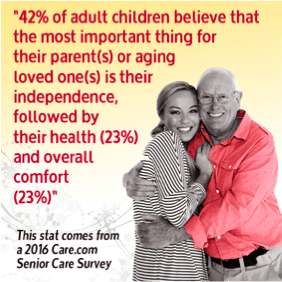By Christine Carruthers, Vice President, Health Services Marketing
 Earlier this year, I went to the annual Argentum (formerly ALFA) conference, where I attended a session featuring a panel discussion about senior prospects, their adult children, and what they each valued in an assisted living community. Many of the panelists felt strongly about the need to appeal not only to the adult child, but also to the senior when marketing a community.
Earlier this year, I went to the annual Argentum (formerly ALFA) conference, where I attended a session featuring a panel discussion about senior prospects, their adult children, and what they each valued in an assisted living community. Many of the panelists felt strongly about the need to appeal not only to the adult child, but also to the senior when marketing a community.
As I provide sales coaching around the country, I often hear adult children say that when they visit an assisted living or skilled care community with their parent, the admissions representative essentially ignores the parent and only tries to sell the community to the adult child. This serves as a reminder that while we traditionally market to the adult child (who often does most of the fact finding prior to a visit), the true customer is the future resident.
Most seniors ultimately make the decision about which assisted living community they move to, and rely heavily on the information collected by an adult child. So when we market senior living services to the adult child, keep in mind they are not always the decision makers, and the prospective resident should be able to relate to the messages we send as well.
When marketing assisted living, keep these 7 things in mind:
1.) Focus digital advertising efforts on the adult child. Most adult children rely on the Internet to find their information. They will typically compare two to three communities prior to calling to schedule a visit. For this reason, digital marketing efforts such as banner ads, digital ads, and squeeze pages should appeal mostly to the adult child who is calling communities and making appointments. When using digital ads, be sure to incorporate links leading the adult child to more information, including, but not limited to, white papers, floor plans or brochures.
>>Sign up for our enewsletter today and get more helpful insights!<<
2.) Target your collateral to the prospect. The prospect will be the one looking at the information the adult child has gathered as a result of digital marketing. While the digital marketing message should be relatable to an adult child, the tangible results of the informative search, such as your collateral, should be focused more on the prospective resident.
3.) Meet your prospects’ expectations for what daily living will be like. The adult child and the prospective resident are concerned about three things: quality of care, day-to-day living and cost. All prospective residents (and adult children) will be asking, “What will I do all day?” The expectations of daily living have changed for assisted living residents just as they have for independent living residents. Marketing efforts should talk about enhanced programs such as life-long learning and interactive engagement because bingo and current events discussions are no longer acceptable ways to pass the time.
4.) Arrange some time with a current resident. The first thing visitors see when they enter your community is the front entrance and reception area. These areas are either helping or hurting your efforts. A lack of activity during a tour is also hindering marketing efforts. To avoid an idle visit, ask a vibrant assisted living resident to meet the prospective resident and adult child for lunch, and meet up with them after they are finished. They will be able to give the prospect a first hand look at how they spend their day. Without speaking to someone who lives it everyday, how else can they actually learn about day-to-day living?
5.) Host events that appeal to both the adult child and the prospect. Use a direct mail piece to invite the adult child and prospect to an event in your community, making sure the subject will be of interest to both parties. Consider creating a guest panel of current residents and their adult children to talk about their experience in choosing a community. You must carefully choose the best day, and since most adult children work, the event should be held later in the afternoon.
6.) Keep a good reputation. Remember the average length of time spent from initial inquiry to making a decision for assisted living is around six months. During that time, they rely on word-of-mouth marketing from neighbors and friends. Your quality of care will be the topic of conversation, and a good reputation within the in-person and online community requires a high quality of care. A good reputation means moving prospects down the pipeline.
7.) Provide testimonials. Know the value of stories and use them strategically through video and written testimonials. Adult children want to see social proof. Among Boomers, 53% are on Pinterest, 48% are on Twitter and 41% use Facebook, making social media a great place to share your story.
As reported in Care.com’s 2016 Senior Care Survey, “72% of people would consider having their parent(s) or aging loved one(s) live with them as a long-term senior care option. In-home care is one of the top three options people think their loved ones would prefer.” Care.com also found that “42% believe that the most important thing for their parent(s) or aging loved one(s) is their independence, followed by their health (23%) and overall comfort (23%). However, 31% of respondents don’t know what the senior in their life would actually prefer. This may be why 51% believe that their aging loved ones should take the lead on long-term senior care planning.”
Be smart about the messages you’re sending, and to whom you’re sending them. Marketing strategy is constantly evolving as the next generation of adult children become more involved in helping their parents find a new home that offers the lifestyle they expect. The challenge is to be always thinking about how to provide the lifestyle they expect, and market that lifestyle effectively.
For more information on how to market to the adult child, contact Christine Carruthers, Vice President, Health Services Marketing at ccarruthers@loveandcompany.com.




